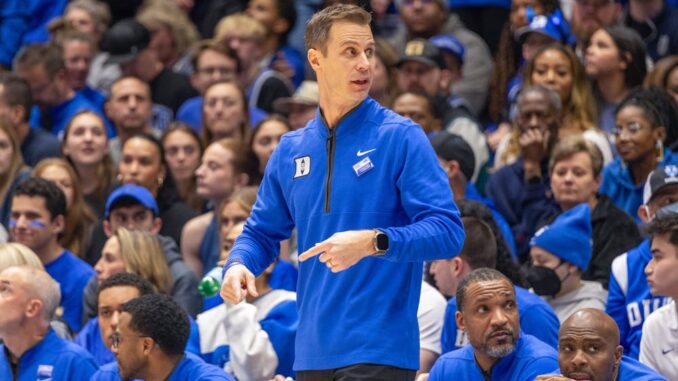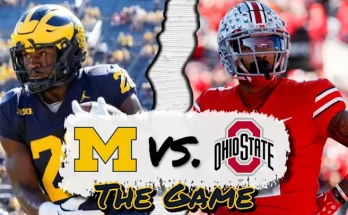In a season marked by high expectations and exceptional performances, the Duke Blue Devils men’s basketball team has encountered a significant setback. Starting guard Tyrese Proctor has been ruled out for the remainder of the season due to a severe left knee injury sustained during the team’s recent victory over Miami. This development comes on the heels of forward Maliq Brown’s dislocated shoulder, further challenging the team’s depth and resilience as they approach the critical phase of the season.
Tyrese Proctor’s Impact and Injury
Tyrese Proctor, a junior guard, has been instrumental in Duke’s success this season. Averaging 12 points per game on 43.8% shooting, along with 3.2 rebounds and 2.3 assists, Proctor’s versatility and leadership have been pivotal. His defensive prowess and ability to orchestrate the offense made him a cornerstone of Coach Jon Scheyer’s strategy.
The injury occurred during the first half of Duke’s commanding 97-60 win over Miami. Proctor appeared to injure his left knee and exited the game with 36 seconds remaining before halftime. Prior to his departure, he had contributed seven points in 14 minutes and surpassed the 1,000 career points milestone, becoming the 70th player in Duke history to achieve this feat.
Initial assessments suggested a bone bruise, with expectations of Proctor’s return this season. However, subsequent evaluations revealed more extensive damage, leading to the decision to sideline him for the remainder of the season. This loss not only affects the team’s on-court dynamics but also removes a seasoned leader from the lineup.
Maliq Brown’s Injury and Team Implications
Adding to the team’s challenges, forward Maliq Brown suffered a dislocated left shoulder during a game against Virginia. The injury, which occurred in the first half of the 80-62 victory, was non-contact in nature. Imaging indicated no severe damage to the labrum, with soreness being the primary issue. Coach Jon Scheyer expressed optimism about Brown’s return this season, stating that his recovery would depend on his healing and pain tolerance.
Brown, who transferred from Syracuse, has been a defensive stalwart for the Blue Devils. Averaging 2.5 points, 4.1 rebounds, 1.6 assists, and 1.4 steals per game, his presence has been crucial to Duke’s defensive schemes. His absence necessitates adjustments in the frontcourt, with opportunities arising for other players to step up.
Stepping Up: Opportunities for Emerging Players
In light of these injuries, the onus falls on other team members to fill the voids left by Proctor and Brown. Freshman guards Caleb Foster and Isaiah Evans are expected to see increased playing time. Foster, who began the season as a key reserve, has demonstrated potential with his scoring and playmaking abilities. Despite a stress fracture in his ankle last season, which sidelined him during the ACC and NCAA tournaments, Foster has returned with determination and is poised to take on a more significant role.
Isaiah Evans, another talented freshman, showcased his capabilities by scoring 16 points in the first half against Miami. His offensive spark and versatility make him a valuable asset as the team recalibrates its strategies. Coach Scheyer’s confidence in Evans’ abilities suggests that he will be a critical contributor in the upcoming games.
In the frontcourt, with Brown’s absence, players like Patrick Ngongbo and Khaman Maluach may see increased responsibilities. Ngongbo, a freshman, has the opportunity to showcase his skills and contribute defensively. Maluach’s experience and defensive acumen will be vital as the team adjusts its rotations.
Navigating the Road Ahead
Despite these setbacks, the Blue Devils have maintained an impressive 25-3 overall record, standing 16-1 in the Atlantic Coast Conference (ACC). Their recent performances, including a decisive victory over Illinois at Madison Square Garden, underscore the team’s depth and resilience.
The coaching staff, led by Jon Scheyer, faces the challenge of reconfiguring the lineup and strategies to adapt to the recent injuries. Scheyer’s approach emphasizes a cautious return for injured players, ensuring their long-term health and readiness. The focus will be on integrating emerging talents seamlessly into the system, maintaining the team’s competitive edge as they approach the ACC tournament and the NCAA postseason.
Historical Context: Injuries and Team Resilience
Injuries are an unfortunate aspect of sports, and the Blue Devils are no strangers to adapting in the face of adversity. Historically, the team has encountered similar challenges. For instance, in the 2023-2024 season, Caleb Foster suffered a stress fracture in his ankle, sidelining him during critical tournaments. The team’s ability to regroup and perform despite such setbacks speaks to the resilience embedded in the program’s culture.
The current situation mirrors past experiences, where the collective effort and next-player-up mentality have propelled the team forward. The emphasis on player development and readiness ensures that when opportunities arise, athletes are prepared to step into more prominent roles.
Fan and Community Support
The Duke community, known for its passionate support, plays a crucial role during such challenging times. Fans, alumni, and students rally behind the team, providing encouragement and fostering an environment of unwavering support. This collective spirit not only boosts player morale but also reinforces the resilience needed to navigate the season’s hurdles.
Engagement through social media, attendance at games, and community events exemplify the solidarity that defines Duke’s basketball culture. This support system is instrumental as the team adapts to recent changes and strives to maintain its trajectory of success.



